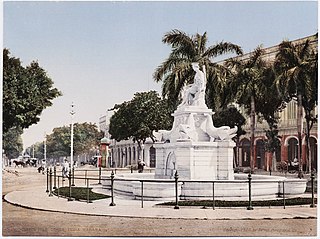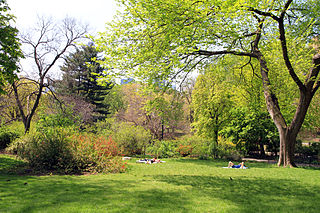
José María Andrés Fernando Lezama Lima was a Cuban writer, poet and essayist. He is considered one of the most influential figures in Cuban and Latin American literature. His novel Paradiso is one of the most important works in Spanish and one of the best novels of the 20th Century according to the Spanish newspaper El Mundo.

Bola de Nieve, born Ignacio Jacinto Villa Fernández, was a Cuban singer-pianist and songwriter. His name originates from his round, black face.
Rock and roll music was introduced in Cuba in the late 1950s, with many Cuban artists of the time covering American songs translated into Spanish, as was occurring in Mexico at the same time. "The Batista police never looked kindly on Rock and Roll, and much less after the screening of films like Rebel Without a Cause and The Bad Seed, among others. After 1959, Rock and Roll followed the same path, although artists like Argentinean Luis Aguile emerged."

Vedado is a central business district and urban neighborhood in the city of Havana, Cuba. Bordered on the east by Calzada de Infanta and Central Havana, and on the west by the Alemendares River and Miramar / Playa district, Vedado is a more modern part of the city than the areas to the east, developed in the first half of the 20th century, during the Republic period. In 2016 it was described by one commentator as the city's "most affluent" section. The main street running east to west is Calle 23, also known as "La Rampa". The northern edge of the district is the waterfront seawall known as the Malecón, a famous and popular place for social gatherings in the city. The area popularly referred to as 'Vedado' consists of the wards of Vedado, Rampa, Vedado-Malecón and Carmelo, all in the municipality of Plaza de la Revolución.

Miramar is a residential district of the municipality of Playa, in the city of Havana.

José Ramón Villa Soberón is a Cuban artist, particularly known for his public sculptures around Havana. He studied at the Escuela Nacional de Arte in Havana, Cuba and the Academy of Plastic Arts in Prague. He is a professor at the Instituto Superior de Arte in Havana. His sculptures, paintings, engravings, drawings and designs are held by the Museo Nacional de Bellas Artes de La Habana, and in 1996 he was one of the selected artist in the second Trienal Americana de Escultura in Argentina.
Eliseo Valdés Erustes is a Cuban artist specializing in sculpture, painting, and drawing.

The Christ of Havana is a large sculpture representing Jesus of Nazareth, on a hilltop overlooking the bay in Havana, Cuba. It is the work of the Cuban sculptor Jilma Madera, who won the commission for it in 1953.
Henry Castellanos Garzón, aka "Romaña", was a Colombian guerrilla commander of the Revolutionary Armed Forces of Colombia. Castellanos Garzón was a member of the Estado Mayor and the Commander of several Eastern Bloc of the FARC-EP fronts.
Jorge "Papito" Serguera was a Rebel Commander and the president of the Cuban Institute of Radio and Television from 1967 to 1974.

Carlos Enrique Prado is a contemporary Cuban artist known primarily for his ceramic sculptures and public art. Currently residing in Miami, Florida, Prado not only continues to create his art but also shares his expertise as a professor at the University of Miami in Coral Gables. With his expertise spanning sculpture, ceramics, drawing, digital art, performance, installations, and interventions, Prado has showcased his versatility and creativity throughout his career. One of his notable recent achievements is the completion of the Ronald Reagan Equestrian Monument, a major public sculpture commissioned by Miami-Dade County, located at the Tropical Park, Miami.


The University of Havana is a public university located in the Vedado district of Havana, the capital of Cuba. Founded on January 5, 1728, the university is the oldest in Cuba, and one of the first to be founded in the Americas. Originally a religious institution, today the university has 15 faculties (colleges) at its Havana campus and distance learning centers throughout Cuba.

The Cuban Friendship Urn, also known as the Cuban–American Friendship Urn or USS Maine Memorial, is a marble statue in Washington, D.C., listed on the National Register of Historic Places. The monument originally stood in Cuba to honor the American deaths aboard the USS Maine preceding the Spanish–American War in 1898.

Fuente de la India is a fountain by Giuseppe Gaggini in Havana, Cuba, at the south extreme of Paseo del Prado, about 100 m south of El Capitolio, between Monte and Dragones Streets. The figure represents the Indian woman "Habana" in whose honor Havana was named.

The Parque Central, Havana is one of the best known and central sites of the city of Havana, Cuba. It is located between Prado, Neptuno, Zulueta and San José streets, and San Rafael Boulevard. Among the buildings surrounding the park are Gran Teatro de La Habana, the Hotel Inglaterra, the Hotel Telégrafo, el Hotel Parque Central, la Manzana de Gómez, the Hotel Plaza and Museo Nacional de Bellas Artes.

A statue of José Martí by Anna Hyatt Huntington is installed in Manhattan's Central Park, in the U.S. state of New York.

The Monumento Encuentro refers to two bronze statues seated on a bench in Colonia Tabacalera, Cuauhtémoc, Mexico City. Otherwise known as the bench of Fidel Castro and Che Guevara and the statues of Fidel Castro and Che Guevara, the artwork features sitting statues of Fidel Castro and Che Guevara, major figures of the Cuban Revolution (1953–1959). The monument references the first time both met in 1955 in Tabacalera.


















